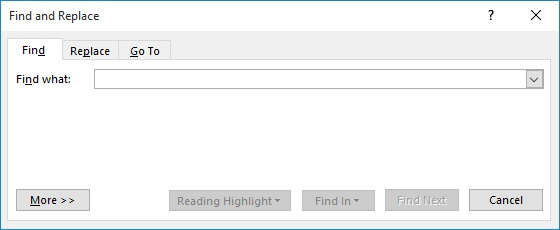Please Note: This article is written for users of the following Microsoft Word versions: 2007, 2010, 2013, 2016, 2019, 2021, 2024, and Word in Microsoft 365. If you are using an earlier version (Word 2003 or earlier), this tip may not work for you. For a version of this tip written specifically for earlier versions of Word, click here: Copying Found Items to a New Document.
Written by Allen Wyatt (last updated August 30, 2025)
This tip applies to Word 2007, 2010, 2013, 2016, 2019, 2021, 2024, and Word in Microsoft 365
Robert notes that Word allows him to locate and highlight all the instances of an item that he enters in the Find dialog box. He wonders if, from that point, there is some way he can select all the highlighted instances so that he can copy and paste them into a new document.
Copying individual items that are found is easy—all you need to do is have the source and target documents open, find what you want in the source document, copy it to the Clipboard, and then paste it into the target document. Copying a bunch of found items at once is a bit trickier, however. Here's how to do it:

Figure 1. The Find tab of the Find and Replace dialog box.
WordTips is your source for cost-effective Microsoft Word training. (Microsoft Word is the most popular word processing software in the world.) This tip (12391) applies to Microsoft Word 2007, 2010, 2013, 2016, 2019, 2021, 2024, and Word in Microsoft 365. You can find a version of this tip for the older menu interface of Word here: Copying Found Items to a New Document.

Discover the Power of Microsoft Office This beginner-friendly guide reveals the expert tips and strategies you need to skyrocket your productivity and use Office 365 like a pro. Mastering software like Word, Excel, and PowerPoint is essential to be more efficient and advance your career. Simple lessons guide you through every step, providing the knowledge you need to get started. Check out Microsoft Office 365 For Beginners today!
In plain-text documents, it is not uncommon to see asterisks used around text to indicate what should be considered bold ...
Discover MoreSearching for different types of words in your documents is a nice thing to contemplate, but it is much harder to do in ...
Discover MoreIf you need to make replacements in your document, the Find and Replace tool is the go-to option. If you want to replace ...
Discover MoreFREE SERVICE: Get tips like this every week in WordTips, a free productivity newsletter. Enter your address and click "Subscribe."
There are currently no comments for this tip. (Be the first to leave your comment—just use the simple form above!)
Got a version of Word that uses the ribbon interface (Word 2007 or later)? This site is for you! If you use an earlier version of Word, visit our WordTips site focusing on the menu interface.
Visit the WordTips channel on YouTube
FREE SERVICE: Get tips like this every week in WordTips, a free productivity newsletter. Enter your address and click "Subscribe."
Copyright © 2025 Sharon Parq Associates, Inc.
Comments